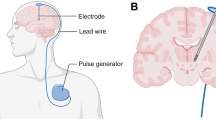Abstract
Chorea-acanthocytosis is a rare autosomal recessive disorder. To date, treatment is only symptomatic and supportive. Results from the few reports of chorea-acanthocytosis patients treated with deep brain stimulation (DBS) have been inconsistent. We present case reports for two patients with chorea-acanthocytosis who received DBS treatment and compare the outcomes with results from the literature. Both patients showed the typical clinical features of chorea-acanthocytosis with motor symptoms resistant to medical treatment. Chorea was significantly improved following low-frequency DBS treatment in both patients. However, dystonia was only mildly improved. Four chorea-acanthocytosis patients treated with DBS treatment have been reported in the literature. One patient had improvement with low-frequency DBS stimulation, while another two had improvement with higher-frequency DBS. One patient, however, did not improve with either low-frequency or high-frequency DBS. Bilateral DBS to the GPi can improve chorea and dystonia in some patients with intractable chorea-acanthocytosis. However, selection criteria for the most promising candidates must be defined, and the long-term benefits evaluated in clinical studies.



Similar content being viewed by others
References
Walker RH, Danek A, Dobson-Stone C, Guerrini R, Jung HH, Lafontaine AL, Rampoldi L, Tison F, Andermann E (2006) Developments in neuroacanthocytosis: expanding the spectrum of choreatic syndromes. Mov Disord 21(11):1794–1805
Ueno S, Maruki Y, Nakamura M, Tomemori Y, Kamae K, Tanabe H, Yamashita Y, Matsuda S, Kaneko S, Sano A (2001) The gene encoding a newly discovered protein, chorein, is mutated in chorea-acanthocytosis. Nat Genet 28(2):121–122
Loher TJ, Burgunder JM, Pohle T, Weber S, Sommerhalder R, Krauss JK (2002) Long-term pallidal deep brain stimulation in patients with advanced Parkinson disease: 1-year follow-up study. J Neurosurg 96(5):844–853
Krauss JK, Loher TJ, Weigel R, Capelle HH, Weber S, Burgunder JM (2003) Chronic stimulation of the globus pallidus internus for treatment of non-dYT1 generalized dystonia and choreoathetosis: 2-year follow-up. J Neurosurg 98(4):785–792
Burbaud P, Rougier A, Ferrer X, Guehl D, Cuny E, Arne P, Gross C, Bioulac B (2002) Improvement of severe trunk spasms by bilateral high-frequency stimulation of the motor thalamus in a patient with chorea-acanthocytosis. Mov Disord 17(1):204–207
Ruiz PJ, Ayerbe J, Bader B, Danek A, Sainz MJ, Cabo I, Frech FA (2009) Deep brain stimulation in chorea acanthocytosis. Mov Disord 24(10):1546–1547
Guehl D, Cuny E, Tison F, Benazzouz A, Bardinet E, Sibon Y, Ghorayeb I, Yelnick J, Rougier A, Bioulac B, Burbaud P (2007) Deep brain pallidal stimulation for movement disorders in neuroacanthocytosis. Neurology 68(2):160–161
Wihl G, Volkmann J, Allert N, Lehrke R, Sturm V, Freund HJ (2001) Deep brain stimulation of the internal pallidum did not improve chorea in a patient with neuro-acanthocytosis. Mov Disord 16(3):572–575
Biolsi B, Cif L, Fertit HE, Robles SG, Coubes P (2008) Long-term follow-up of Huntington disease treated by bilateral deep brain stimulation of the internal globus pallidus. J Neurosurg 109(1):130–132
Yianni J, Nandi D, Bradley K, Soper N, Gregory R, Joint C, Stein J, Scott R, Aziz T (2004) Senile chorea treated by deep brain stimulation: a clinical, neurophysiological and functional imaging study. Mov Disord 19(5):597–602
Berweck S (2009) BP-DBS for dystonia-choreoathetosis cerebral palsy. Lancet Neurol 8(8):692–693
Conflict of interest
There is no actual or potential financial and other conflict of interest related to the submitted manuscript.
Author information
Authors and Affiliations
Corresponding authors
Rights and permissions
About this article
Cite this article
Li, P., Huang, R., Song, W. et al. Deep brain stimulation of the globus pallidus internal improves symptoms of chorea-acanthocytosis. Neurol Sci 33, 269–274 (2012). https://doi.org/10.1007/s10072-011-0741-y
Received:
Accepted:
Published:
Issue Date:
DOI: https://doi.org/10.1007/s10072-011-0741-y




